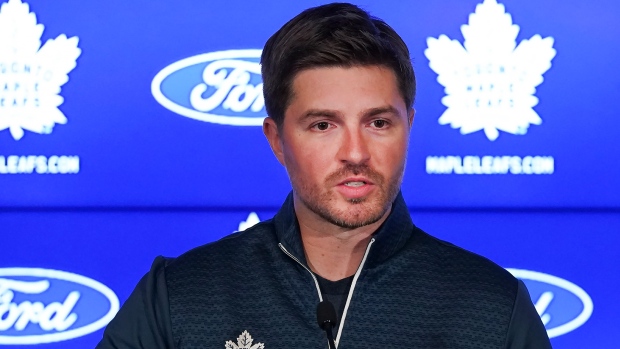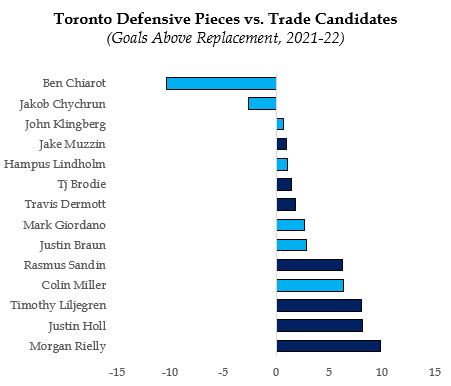Mar 7, 2022
Dubas set to make a fascinating wager
Maple Leafs GM says he’s eyeing blueline help ahead of the trade deadline, showing a willingness to double down on a struggling goaltending duo and a core that has gone quiet offensively in previous postseasons, Travis Yost writes.
By Travis Yost

In the past couple of weeks, Toronto Maple Leafs general manager Kyle Dubas has indicated his team will leverage remaining cap flexibility to upgrade the defensive position ahead of the Stanley Cup Playoffs.
How much cap space is going to be available to do that remains unclear – the team’s right against the salary cap ceiling, but defenceman Jake Muzzin’s $5.6-million cap hit is still on long-term injured reserve. Muzzin remaining on LTIR would give Toronto the flexibility to be aggressive (as opposed to targeted) at the deadline, but also comes at the cost of not having the 33-year-old veteran in the lineup.
What’s more interesting is Dubas telegraphing Toronto’s preferred move here. In past seasons, Toronto’s need to upgrade the defensive position was obvious – most of the team’s valuable assets were in the forward ranks, and the team’s poor showings and ugly losses generally coincided with miscues and breakdowns all over the defensive zone.
But this lineup is a bit different. Toronto has again been one of the best performers this regular season – sixth in goal differential (+0.8 per 60 minutes), and third in expected goal differential (+0.7 per 60 minutes). They are a bona fide Stanley Cup contender this time around. A six-year trended graph illustrates how far this club has come in the Auston Matthews era:

One of the interesting parts of this season is that Toronto is defying expectations on both ends of the ice. Offensively, the Maple Leafs are generating heaps of shooting volume from dangerous areas, and their shooters have been able to capitalize on a significant amount of those chances (10.5 per cent shooting percentage). Defensively, only two teams concede fewer expected goals than Toronto. And yet the Maple Leafs are a so-so defensive team by most measures, with actual goals conceded dwarfing expectations.
Lately, Toronto’s goaltenders have drawn most of the ire. Jack Campbell (91.5 per cent stop rate) and Petr Mrazek (89.1 per cent stop rate) were the low-cost tandem the front office bet on this year, and results have started to underwhelm. Campbell's season started off promising, but right now neither can seem to buy a save. Campbell’s numbers may be little to balk at, but remember, we think Toronto goaltenders have had some of the easiest workload found around the league.
There is no doubt they are in a swoon right now. But significant divergence between goals and expected goals raises the age-old question: How much of this is on the goalies, and how much is weak defensive play in front contributing?

I’m not sure Toronto has figured out how to apportion the recent defensive breakdowns – looking for defensive upgrades says quite a bit, but it could also be reflective of what’s available on the trade block. Finding a second-pairing defender, for example, is going to be easier and relatively less cost prohibitive than another goalie.
It gets more interesting when you break it down to the player level. Toronto’s expected goals numbers may be in line, but what’s true for the averages may not be true for any one player.
Let’s look at seven Maple Leafs defenders, splitting the regular season so far in half:

Toronto’s defence isn’t playing the same quality of hockey it did in the first half of the year, but the lion’s share of pressure seems to be borne from an inability to get a save. Only Timothy Liljegren has seen a material change for the worse in expected goal rates against, and he’s a third-pairing player.
So, if you are pursuing a defensive piece, which of these players are you going after, and which are you replacing? Because for the most part, Toronto’s blueline has held up in ways most others (save perhaps Buffalo’s Colin Miller) haven’t:

It is a fascinating gambit by Toronto. The core is already here, and it’s on them to pave the way to the Stanley Cup. It’s also a core that has famously gone quiet offensively in the playoffs. And so, putting the remaining cap space on defensive improvements is a reaffirmation on two fronts: a doubling down on this year’s goaltending tandem, and a doubling down on the scoring firepower the team has amassed over the past few seasons.
Let’s see if it’s the right wager.
Data via Natural Stat Trick, Evolving Hockey, NHL.com, HockeyViz

